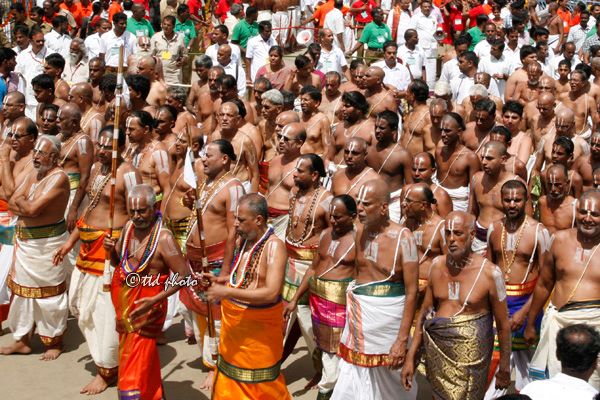Article by – Sri Anantha Madabhooshi
Divya Prabandha Ghoshti
The annual 9-day festival originally believed to be initiated by Lord Brahma Himself aeons ago, the Tirumala Brahmotsavam, continuously gets better in execution year after year. This festival is not like any other festival held in Tirumala for Lord Malayappa Swami.
What makes this unique is the fact that this is open to all who can visit Tirumala during those nine days and that throws a huge challenge in terms of managing lakhs of devotees who throng to have a glimpse of the Lord on 15 celestial vahanas bedecked with jewels.
The other great aspect is continuation of the codified tradition established by Sri Ramanuja almost a thousand years ago on what divine songs of Alwars to be recited and when the 2 Jeeyangars or the pontiffs, who are called H H Periya Koil Kelvi Appan and H H Siriya Koil Kelvi Appan, lead the holy congregation called ‘Divya Prabandha Ghoshti‘ who could sing the Divya Prabandham, all of 4000 hymns, recalling from their memory without any written aid.
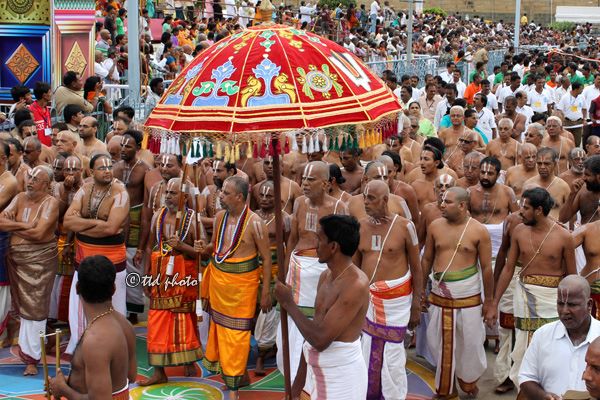
Another striking aspect, as in other Vishnu temples also, is this Ghoshti leads the procession of the Brahmotsavam and it is established that the Lord follows this Ghoshti in an attempt to relish this Divine nectar of Divya Prabandham.
Now, let us get into the details of the recitation practice established and followed in Brahmotsavams.
Mudhal Thiruvandaadi
In the evening of the first day Lord along with His Consorts, Sridevi and Bhudevi, take the Pedda Seshavahanam. The Lord and His Consorts eagerly wait till they arrive at Tirumalai Nambi Sannidhi on South Mada street, to follow the Ghoshti. The Ghoshti begins with the first-ever Prabandham of the first Alwar called Poigai Alwar.
The jeeyangars lead the Ghoshti in reciting ‘Mudhal Thiruvandaadi‘ which has 10 hymns out of the full 100, dedicated to Lord Srinivasa. The next day morning, Lord Srinivasa, takes a small Sesha vahana, in memory of Lord Namperumal [Utsava vigraha of Sri Ranganatha of Srirangam], who stayed in Tirumala for nearly 40 years way back in the 13th century.
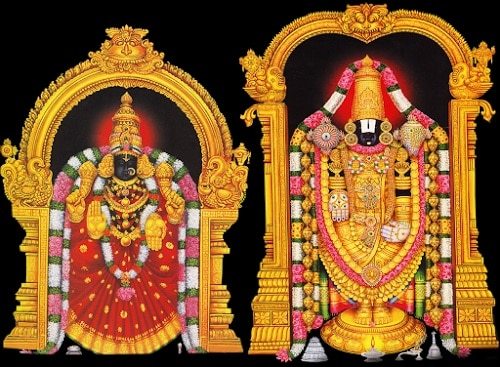
Irandam Thiruvandaadi
In the evening, the Lord adorns the decoration of Saraswati devi and a procession is held on Hamsa vahana. Bhoothathalwar’s ‘Irandam Thiruvandaadi‘ is recited in both the sessions.
Moondram Thiruvandaadi
Simha Vahana and Muthyapu Pandiri vahana are scheduled for 3rd day’s morning and evening sessions respectively. The Ghoshti recites the 3rd Alwar, Peyalwar’s ‘Moondram Thiruvandaadi’.
This Alwar has dedicated 19 songs in praise of Lord Srinivasa in his 100 songs.
Nanmugan Thiruvandaadi
Devotees witness Lord’s procession on Kalpaka Vruksha Vahana in the morning and Sarvabhupala Vahana in the evening session and as befitting it may for Sarvabhupala Vahana, the Ghoshti recites ‘Nanmugan Thiruvandaadi’ which establishes unequivocally the Lord’s Lordship above every other deity.
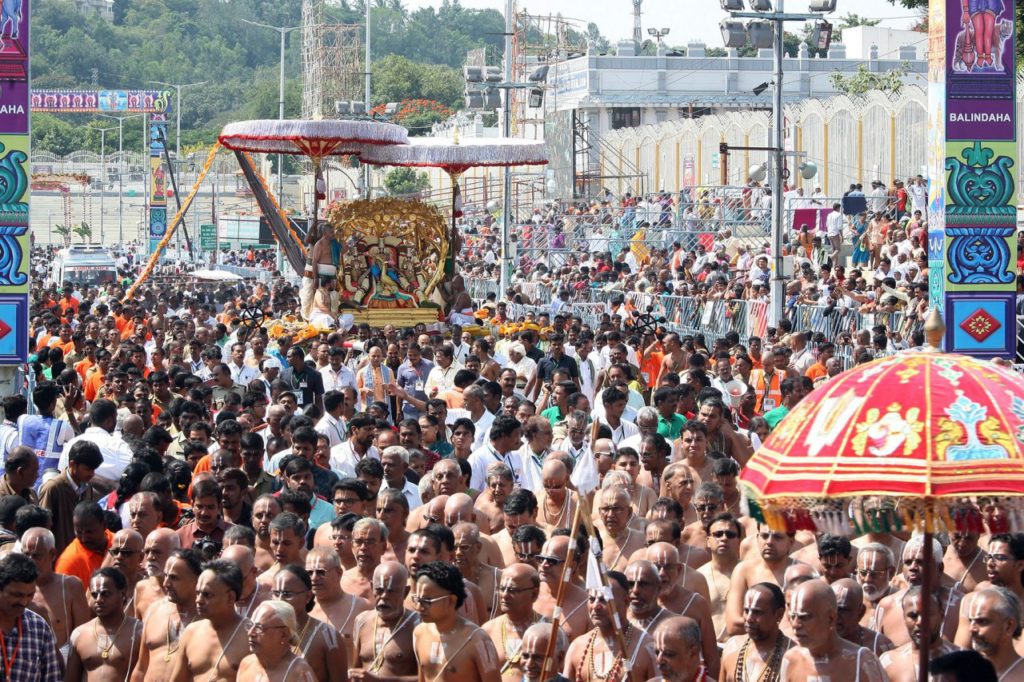
Thiruviruttam of Nammalwar
This special day paves the way for lakhs of devotees to worship Lord Malayappa in Mohini avataram in a special palanquin followed by Lord Sri Krishna beside the palanquin. Lord Krishna is given higher precedence over Lord Malayappa in Mohini avataram in offering the Harathi while this procession is going on.
In the evening Lord Malayappa rides on His primary Vahana, Garuda. Jeeyangars lead the Ghoshti by reciting the ‘Thiruviruttam of Nammalwar’.
Periya Tiruvandaadi
Lord Malayappa is decorated as Rama and He rides on the back of Hanuman in the morning and in the evening He takes Gaja vahana. ‘Periya Tiruvandaadi’ of Nammalwar is recited by the Ghoshti.
Day 6 also marks the Lord and His consorts riding an opulent Golden Chariot as part of Vasanta Utsavam in the evening before Gaja Vahanam. No recitation takes place while the Lord moves on the Golden Chariot.
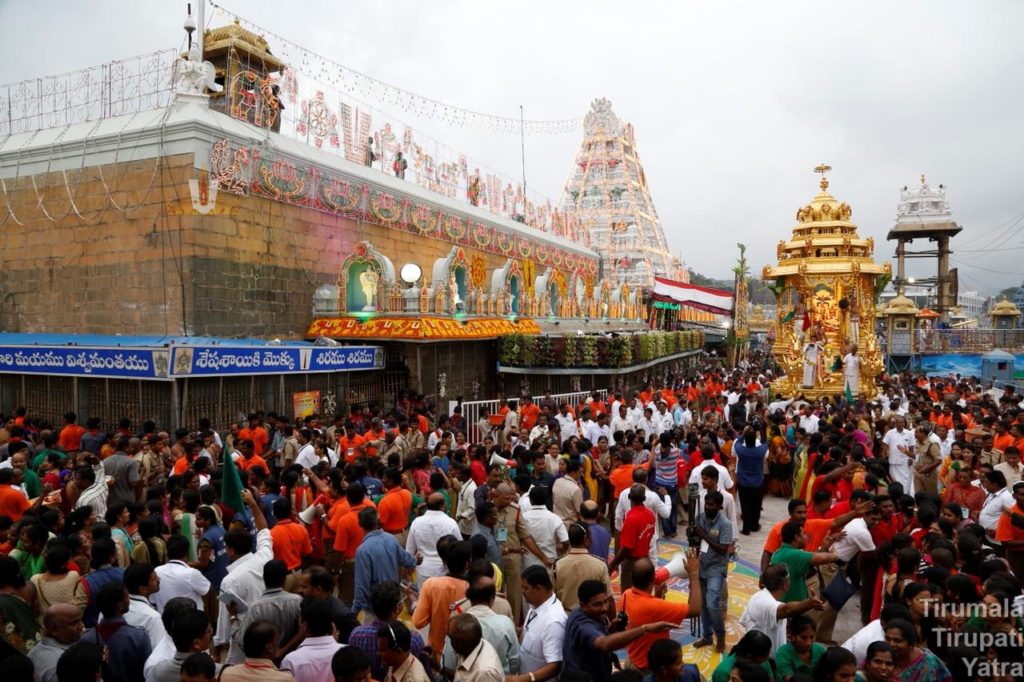
On all these 6 days, for the rest of the distance Lord covers to return to the temple. After finishing off the respective Divya Prabandhams, the Ghoshti will recite Periyalwar’s Tiruppallandu and Periyalwar Tirumozhi also.
Periya Tirumozhi
Vedas and Puranas proclaim Lord Narayana as the one residing in the abode of Sun [Surya mandala madhyavarthi]. Lord Malayappa, who is none other than Lord Narayana Himself, takes the seat amidst the Surya Prabha in the morning and further, He traverses amidst the Chandra Prabha in the evening.
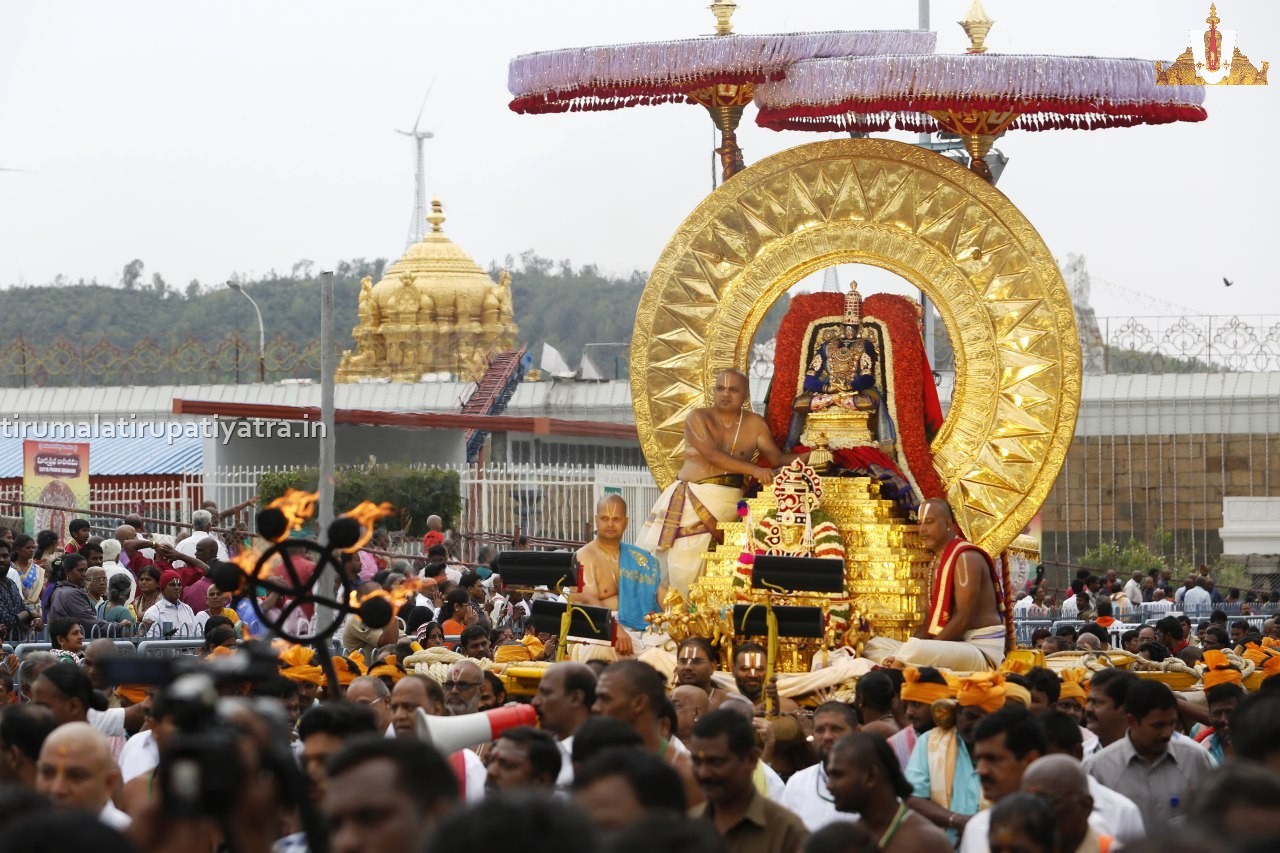
The morning session marks the beginning of the recitation of Tirumangai Alwar’s magnum opus, ‘Periya Tirumozhi’ by the Ghoshti. It is continued in the evening also.
Periya Tirumozhi & Nachiyar Tirumozhi
Lord Malayappa Swami accompanied by His two consorts takes a tall chariot and ‘Periya Tirumozhi’ is continued for the morning session while the chariot navigates through the streets around the temple. In the evening, Lord Malayappa rides a brisk Horse, Aswa vahana. Ghoshti recites Andal’s ‘Nachiyar Tirumozhi’ during this session.
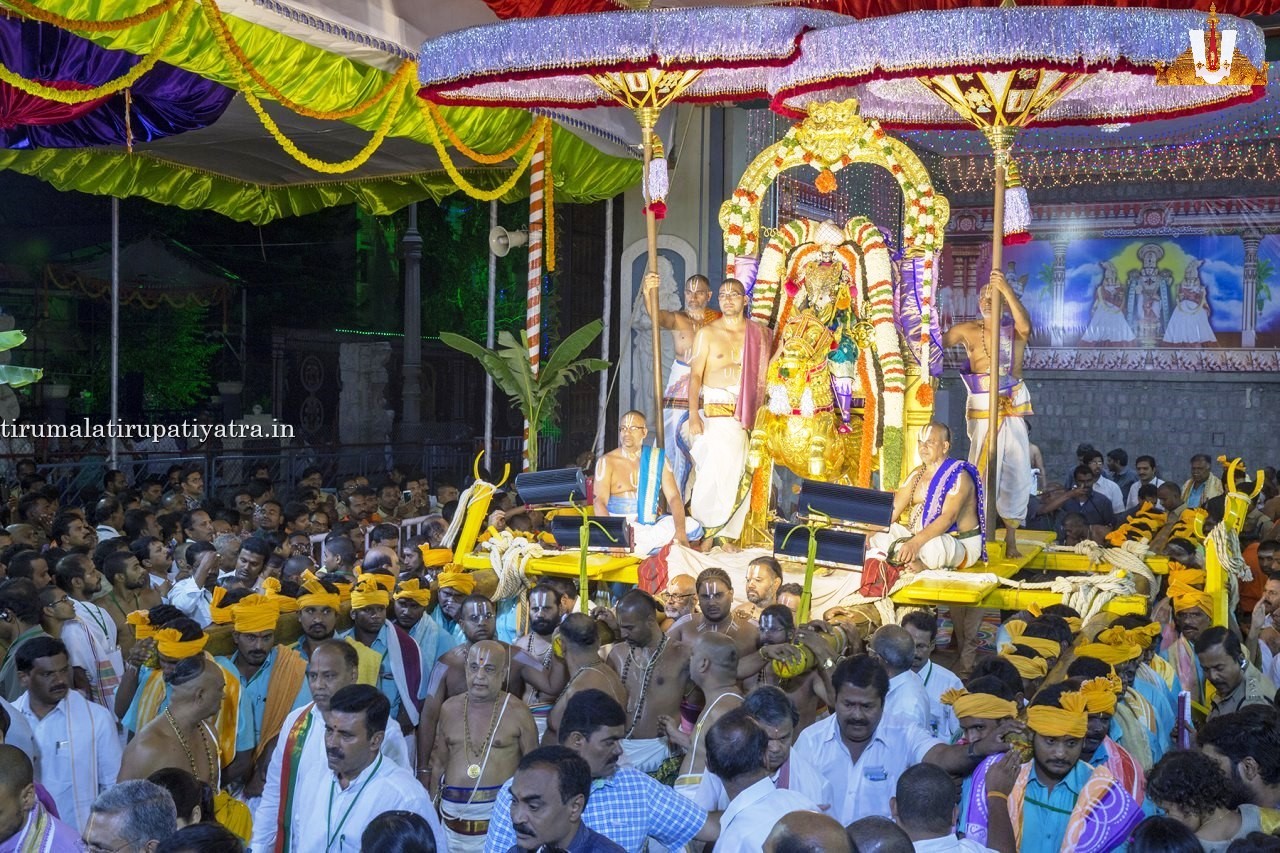
Final Day
The final day coincides with Sravana star of Purattasi month. This is the avatara star of Lord Srinivasa. On this day in the morning, Churnabhishekam will be held and the Ghoshti will recite the remaining prabandhams like Perumal Tirumozhi, Tirucchandaviruttam, Tirumaalai, Amalanadhipiram.
Thereafter, the Lord with His consorts and Sudarsana Alwar are taken to Sri Varahaswami temple on the banks of Swami Pushkarini and Tirunedunthandakam of Tirumangai Alwar is recited.
After the Thirumanjanam and Chakrasnanam, Theertha prasada will be distributed to the Ghoshti. During the Tiruvaaradhana, Ghoshti recites Tiruppalliezhuchi, Tiruppavai, Tiruppalandu, Kanninunsiruththambu, Koil Tiruvoymozhi, Ramanuja Nootrandadhi and Upadesarathnamala of Swami Manavalamaamunigal.
Brahmotsavam concludes
Brahmotsavam concludes with the evening session of Dhwaja Avarohanam event which is followed by a recitation of Ramanuja Nootrandadhi and Upadesarathnamala. Navarathri Bramhotsavam which happens once in 3 years also follows the same recitation pattern.
It is Sri Ramanuja who established rituals and practices in Tirumala. It is a miracle that tradition is still exists and followed without any compromises even after 1000 years and TTD plays a major role in continuing the legacy.
